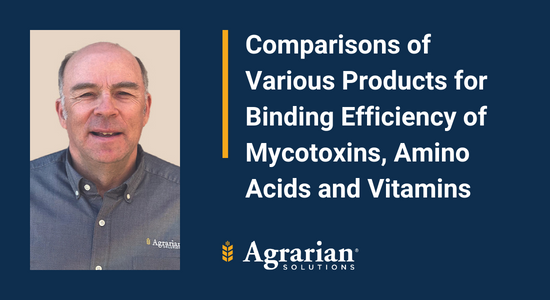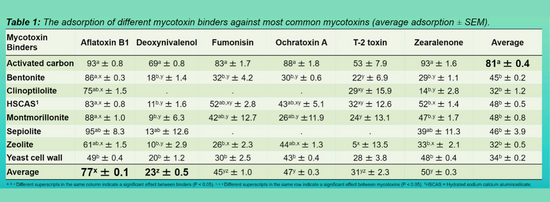Comparisons of Various Products for Binding Efficiency of Mycotoxins, Amino Acids and Vitamins

Written By: Larry Roth, Ph.D., PAS Vice President of Nutrition
Several products are marketed for their ability to bind mycotoxins and thereby protect food-producing animals from the harmful effects of mycotoxins. Recent research has raised concerns about the inability of these products to adequately protect animals by sequestering mycotoxins, and may in fact reduce the availability of amino acids and vitamins.
Table 1. In vitro Efficacy of Mycotoxin Binding by Various Mycotoxin Binder Types

¹Kihal et al (2022) conducted a meta-analysis of 68 peer-reviewed research studies to determine the percentage mycotoxin adsorption by various mycotoxin binder products (MTB). The analysis found that mycotoxin adsorption is highly variable, with aflatoxin being the highest and deoxynivalenol being the least. In addition, activated carbon (charcoal) was the most effective MTB across mycotoxin type; however, considerable variation in pore size exists due to source and processing. Earlier research (²Kihal et al., 2020) evaluated adsorption by the MTB for vitamins and amino acids. When the water- and fat-soluble vitamins D and E were incubated together, the MTB adsorption average 35% for the water-soluble vitamins and 37.2% of the vitamin E, while minimal vitamin D was bound. The researchers incubated the amino acids lysine, methionine, threonine and tryptophan together with the MTB and found that 19% of the amino acids were bound.
Summary
Common MTB are ineffective for adsorption of mycotoxins, except aflatoxin; further, the MTB did bind water-soluble vitamins and vitamin E, as well as amino acids. Rations including common MTB should be adjusted for reduced vitamin and amino acid availability.
--
1Kihal et al (2022). J. Anim. Sci. 100:1-14.
2Kihal et al (2020). J. Dairy Sci. 103:3125-3132.